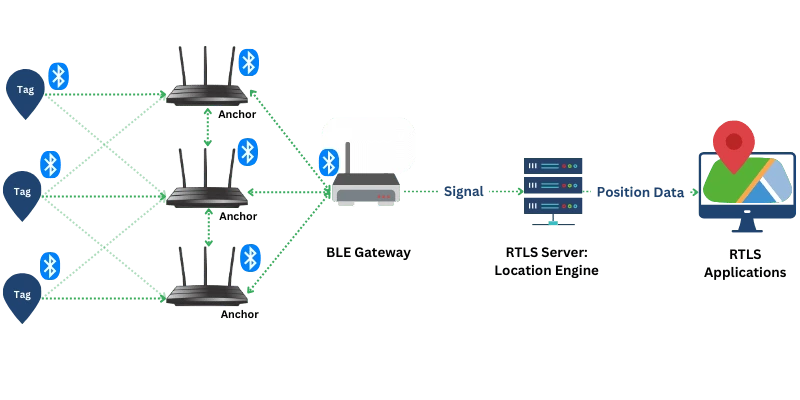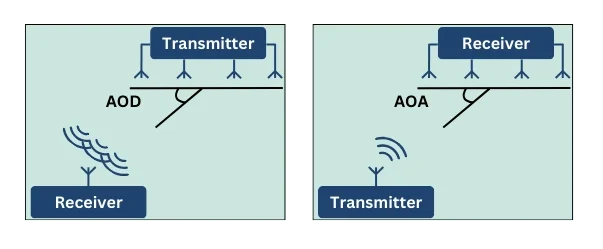Understanding Bluetooth Low Energy
Bluetooth Low Energy (BLE) is a wireless communication technology that uses radio frequencies to connect devices and track locations. It is widely used in various indoor positioning applications such as asset tracking, proximity services, and indoor navigation. BLE’s popularity is due to its compatibility with many modern devices like smartphones and IoT systems, as well as its widespread presence in most indoor spaces.
Beyond general wireless connectivity, BLE plays a crucial role in Real-Time Location Systems (RTLS), enabling the tracking and monitoring of the movement or location of objects, individuals, and assets in real time using tags and receivers.
Compared to other location technologies, BLE RTLS stands out for its affordability, scalability, and low power consumption, making it an ideal solution for industries like healthcare, logistics, and retail.

How Does BLE Work?
BLE enables real-time tracking and indoor positioning by transmitting data between small, low-power devices, such as tags and sensors. These tags emit radio signals, which are captured by receivers or anchors strategically placed within a defined space. The signals are then analyzed to calculate the precise position of the tags.
Here’s a step-by-step breakdown of how BLE operates in RTLS:
- Signal Transmission: BLE tags transmit small data packets containing unique identifiers and signal strength information over short distances using Bluetooth radio waves. Due to their energy-efficient design, these tags can operate for years on minimal battery power.
- Signal Reception: Fixed BLE receivers or gateways, installed at strategic points in the environment, capture the signals emitted by the tags. In some setups, mobile devices like smartphones can also act as receivers.
- Position Calculation: The location of a tag is determined using advanced techniques such as:
- RSSI (Received Signal Strength Indicator): Measures signal strength to estimate the distance between the tag and receiver.
Trilateration: Combines distances from multiple receivers to calculate the precise position of the tag. - Angle of Arrival (AoA) and Angle of Departure (AoD): Uses the direction of incoming or outgoing signals to enhance accuracy.
- Proximity Detection: Identifies when a tag is near a receiver, ideal for triggering notifications or events in simpler applications.
- RSSI (Received Signal Strength Indicator): Measures signal strength to estimate the distance between the tag and receiver.
- Location Data Processing: The captured data is processed locally on the gateway or transmitted to a central system, often hosted on the cloud. Advanced algorithms analyze this information to improve location accuracy and provide actionable insights.
- Integration with Applications: The processed location data is integrated into various applications, such as asset tracking, navigation systems, or personnel monitoring platforms. These applications display real-time insights, enabling efficient decision-making and operational optimization.

How Accurate is BLE RTLS Technology?
BLE technology typically provides positioning accuracy within 1–5 meters under optimal conditions. With the introduction of Bluetooth 5.1 and its direction-finding features, such as AoA and AoD, BLE can achieve sub-meter accuracy in certain setups.
What is the Range of BLE?
The range of BLE RTLS depends on the deployment environment and system setup:
- Typical Range: 10–30 meters (33–100 feet) indoors, influenced by obstacles like walls or furniture.
- Maximum Range: Up to 100 meters (328 feet) in open spaces or line-of-sight conditions.
- Reduced Range: In environments with significant interference or non-line-of-sight scenarios, the effective range may decrease.
Why Choose BLE?
Key Advantages for Buyers
Energy Efficiency: BLE is designed for ultra-low power consumption, enabling devices like tags to operate for months or even years on a single battery. This makes it ideal for IoT applications and large-scale deployments.
Affordability: BLE hardware is widely available and cost-effective due to its integration into billions of consumer devices worldwide, making it a budget-friendly choice for businesses.
Ease of Deployment: BLE systems are straightforward to deploy, requiring minimal infrastructure. Many devices, such as smartphones, already support BLE, eliminating the need for specialized receivers.
Scalability: BLE networks can handle a large number of devices in a single system, making it suitable for businesses scaling their tracking and monitoring operations.
Interoperability: BLE works seamlessly with existing devices and infrastructure, including smartphones, tablets, and IoT platforms, supporting cross-platform communication and integration.
Versatility: BLE supports diverse applications, from asset tracking and indoor navigation to proximity marketing and workforce management, adapting to various industry needs.
Broad Compatibility: BLE operates on universally adopted Bluetooth protocols, ensuring compatibility across devices and regions, making it highly accessible.
Advancements in Accuracy: With the introduction of Bluetooth 5.1, BLE now supports advanced direction-finding techniques such as AoA and AoD, allowing for sub-meter accuracy in certain applications.
Bluetooth Special Interest Group Standards for BLE
BLE technology is built on the Bluetooth Core Specification maintained by the Bluetooth Special Interest Group (SIG):
- Bluetooth 4.0: Introduced BLE with a focus on low power consumption.
- Bluetooth 5.0: Enhanced range, speed, and broadcasting capabilities, including coded PHY for extended range.
- Bluetooth 5.1: Introduced direction-finding features (AoA and AoD), enabling sub-meter accuracy.
- Bluetooth 5.2 and Beyond: Continued improvements in energy efficiency, security, and data throughput.
BLE’s foundation in these standards ensures interoperability, reliability, and consistent performance across devices and applications.
Frequency and Signal Structure of BLE
Frequency: BLE operates within the globally available 2.4 GHz ISM band, ensuring worldwide compatibility.
Signal Transmission: BLE uses Gaussian Frequency Shift Keying (GFSK) modulation for efficient and reliable data transfer.
Bandwidth: BLE channels are 2 MHz wide, with 40 channels available, providing sufficient data rates for most IoT and RTLS applications.
Security Features: BLE includes built-in protocols like AES-128 encryption to ensure secure communication.
Applications of BLE RTLS
Retail & Marketing: BLE tags are widely used for proximity marketing, sending targeted offers and information to customers’ smartphones in stores.
Healthcare: BLE-powered systems track medical equipment, monitor patient locations, and ensure hospital safety.
Logistics & Warehousing: BLE tags are deployed to track inventory and improve warehouse operations.
Hospitality: Hotels and venues use BLE for indoor navigation and personalized guest experiences.
Limitations of BLE RTLS
Accuracy Constraints: BLE traditionally relies on RSSI, which provides meter-level accuracy. However, Bluetooth 5.1’s direction-finding features improve accuracy significantly.
Range Limitations: BLE’s range typically reaches up to 100 meters indoors under optimal conditions, but this may not suffice for long-distance tracking needs.
Interference Susceptibility: BLE uses techniques like adaptive frequency hopping (AFH) to mitigate interference with other technologies in the 2.4 GHz band, such as Wi-Fi.